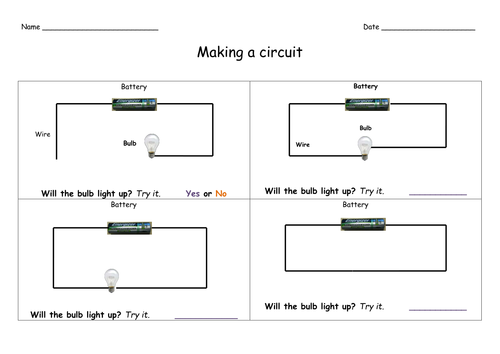Simple Circuit Worksheet

Learning about how electric circuits work is fun! You are going to use so many electrical devices in your lives that it's really important to have some sort of idea about how they work.
Starcraft 2 wings of liberty download free full game torrent free. Working with circuits gives you important knowledge that will help you to use things correctly, to work out why things might not work and how to put that right. In this worksheet there are lots of different circuits drawn for you. All you have to do is to look at them carefully and decide whether it's going to work or not.
Notes: Students may (properly) ask, “Why is there such a thing as a component whose sole purpose is to impede the flow of electrons?” While resistors may seem rather pointless at first, they end up being extremely valuable electrical/electronic components. If asked, you may cite several uses of resistors in circuits: • To limit maximum circuit current to a safe value. • To “split” a voltage into proportions.
• To “scale” meter movements, for precise measurement of current and voltage. • To provide a non-shorting path to discharge static electricity. Notes: Students often find the terms “open” and “closed” to be confusing with reference to electrical switches, because they sound opposite to the function of a door (i.e. You can only go through an open door, but electricity can only go through a closed switch!). The words actually make sense, though, if you look at the schematic symbol for an electrical switch as a door mounted “sideways” in the circuit. At least visually, then, “open” and “closed” will have common references.
One analogy to use for the switch’s function that makes sense with the schematic is a drawbridge: when the bridge is down (closed), cars may cross; when the bridge is up (open), cars cannot. I have found that the concept of electrically common points is most helpful when students first learn to relate voltage drop with continuity (breaks or non-breaks) in a circuit. To be able to immediately relate the expected voltage drop between two points with the electrical continuity between those points is a very important foundational skill in electrical troubleshooting. Without mastery of this skill, students will have great difficulty detecting and correcting faults in circuits caused by poor connections and broken wires, which constitute a fair portion of realistic circuit failures. Notes: Students often find the terms “open” and “closed” to be confusing with reference to electrical switches, because they sound opposite to the function of a door (i.e. You can only go through an open door, but electricity can only go through a closed switch!).
Some of the worksheets displayed are Electricity unit, Simple circuits work, Lab 5 simple electrical circuits, Circuits work, Circuit work answers, Electricity and magnetism simple circuits, Circuit a circuit b, Conductors and insulators. Once you find your worksheet, click on pop-out icon or print icon to worksheet to print or download.
The words actually make sense, though, if you look at the schematic symbol for an electrical switch as a door mounted “sideways” in the circuit. At least visually, then, “open” and “closed” will have common references. One analogy to use for the switch’s function that makes sense with the schematic is a drawbridge: when the bridge is down (closed), cars may cross; when the bridge is up (open), cars cannot. I have found that the concept of electrically common points is most helpful when students first learn to relate voltage drop with continuity (breaks or non-breaks) in a circuit. To be able to immediately relate the expected voltage drop between two points with the electrical continuity between those points is a very important foundational skill in electrical troubleshooting. Without mastery of this skill, students will have great difficulty detecting and correcting faults in circuits caused by poor connections and broken wires, which constitute a fair portion of realistic circuit failures. Notes: Many multimeters use “international” symbols to label DC and AC selector switch positions.